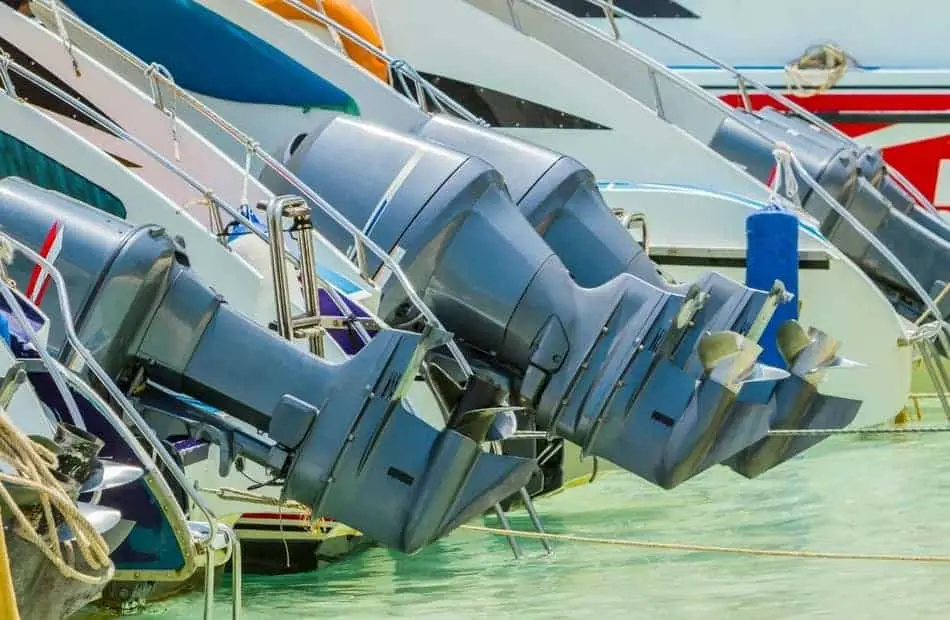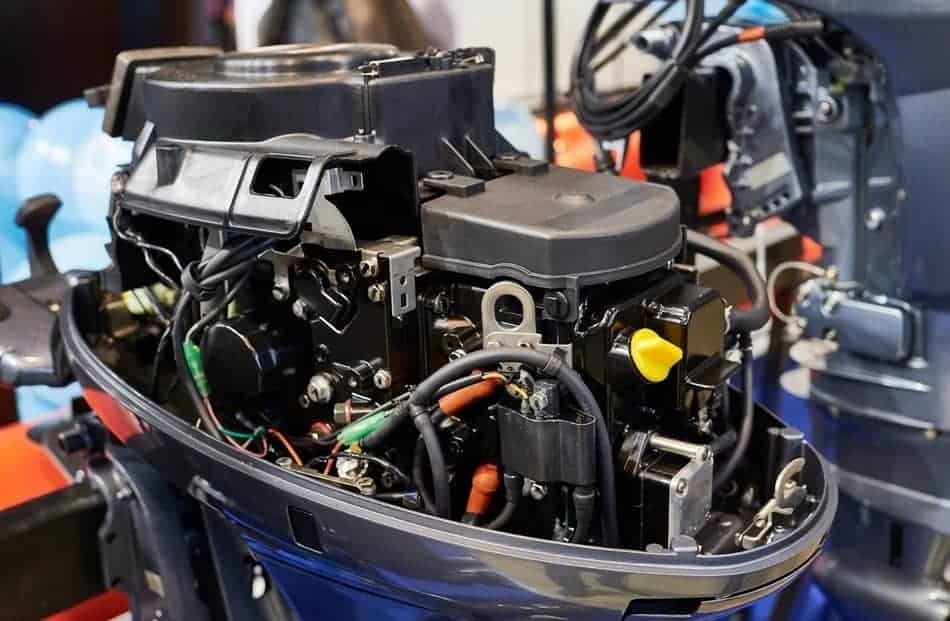“Don’t start your boat engine (outboard) without placing it in the water” “Don’t dry start your boat engine”… heard these types of similar sayings from many of your friends or family or others and wondering why boat engines (outboards) need water? Let’s see in a detailed and simple way.
The boat engines need water because the water cools down the engine by flowing inside it over the power and cylinder heads, absorbing the heat. Without the water, the engine overheats because the impeller melts down without water flowing through, resulting in not pumping the water inside the engine.
When the boat’s engine is turned on, it burns the gas and generates heat inside the cylinders. The raw water (lake or outside water) is sent inside the engine block over the power & cylinder heads, absorbing that heat to cool that heat. The water absorbs heat and becomes (warmth) hot, and then comes out of the engine through the exhaust.
The constant water flow inside the boat’s engine over the power and cylinder heads will absorb the heat by diminishing engine overheat chances. Regardless of the type of engine, outboard or inboard, or sterndrive, the engine needs water (raw water or a combination of freshwater & coolant) to cool it down.
The only exception is for the engine with a closed-loop cooling system (seen in very few boat engines or outboards) rather than a raw water cooling system (seen in most boat engines or outboards), where the coolant runs inside the engine block rather than the raw water.
Most newer marine engines use a closed-loop cooling system, which uses a combination of fresh water and coolant to circulate inside the engine block and the heat exchanger–but cooling it with raw water from outside the boat via a heat exchanger.
Discover boating
If the boat engine (outboard or inboard or sterndrive) doesn’t overheat, then all those different cooling systems (raw water or closed-loop cooling system) are not required for a boat engine. This post is on an outboard motor; however, the same principle will work for the inboard and sterndrive engines.
Related post – Why are boat engines (outboards) so expensive? Check this article to know the main reasons why outboards are expensive in general.

Can you start a boat without water?
Since water is crucial for the boat engine’s cooling system, what happens if you start a boat’s engine without placing it in the water? Can you start a boat engine without water? Will it hurt the boat engine, or dry starting the engine isn’t recommended?
You can start the boat without water, but it melts down the impeller due to heat (friction) without water. If the impeller is gone, it can’t pump the water inside the engine block, thus overheats the engine ultimately. So, it’s advised not to start the boat without water for 5-10 seconds or more.
The impeller (which is made out of rubber) melts down as an immediate result in less than 5 seconds or 10 seconds or more sometimes. The impeller is used to pump the water inside the engine block. If the impeller melts down, water can’t be pumped inside the engine block; thus, the engine overheats ultimately. Check the video below for illustration.
The impeller rotates along with the driveshaft inside a small housing (“aluminum” tube kind of structure) for pumping the water inside the engine block. It pumps the water by varying pressure due to the constant rotation of impeller vanes towards the inner walls of one side of the tube (creating more room for water to move up on the other side).
Water acts as a lube between the inner walls of the housing and the impeller’s vanes. The constant rotation of the impeller’s rubber vanes towards the tube’s inner walls without water will meltdown the rubber vanes due to increased friction (friction between two surfaces increases, then heat increases).
If water is there, it acts as a lube and reduces friction drastically, which decreases the heat and increases the impeller’s life span drastically. The whole problem is due to the impeller’s meltdown, which results in not sending water inside the engine block to cool down the engine.
If the impeller is exactly in the housing center, it will turn with the driveshaft. Spinning the impeller within the “aluminum” housing over it will not pump water up. So, it is designed with an offset impeller.
When the impeller turns, it has a lot of room on one side of the pump and not much room on the other. As the driveshaft and impeller spin, water enters on the side that has a lot of room and is pressured out on the side that doesn’t have much room.
Village Science
Check this awesome short video on how the impeller inside an outboard works to get a clear-cut idea about how it is going to meltdown without the presence of water, thereby stopping the water flow to the engine block, causing the engine to overheat ultimately.
How long can you run a boat engine without water?
Although running a boat without water isn’t highly recommended for a long time, but how long can you can actually run a boat’s engine without water? Does it hurt the boat engine immediately just after turning it on without water?
You can run a boat engine without water for 5-10 or fewer seconds without bothering about any losses. After 5-10 seconds (sometimes more or less than that time), the impeller vanes could meltdown due to heat, resulting in not pumping water inside the engine block, letting the engine overheat.
As you can see on the video, the impeller vanes are constantly rubbing towards one side of the housing. If there is no water, the friction between that surface and the impeller vanes increases, increasing the temperature, ultimately resulting in impeller vanes meltdown.
If the impeller vanes melt, then the pressure difference can’t be created inside that housing to pump the water up into (inside) the engine block. If there is no constant water flowing inside the engine block, it will overheat the engine and causes some severe losses.
Finally, starting the boat (engine) without or out of the water would quickly destroy the water pump’s impeller, and the engine would stall out from overheating due to no water flow inside the engine block. So, don’t start the boat engine for more than 5-10 seconds without placing it in the water to avoid most problems.
How does the boat engine’s cooling system work?

After knowing the water’s needs for a boat engine and the effects of dry starting the boat engine, we will now see how the boat engine’s cooling system works?
The water pump located at the engine’s bottom pumps raw water into the engine block, where it circulates over the cylinder heads, absorbing heat from them. And if that water reaches a specific temperature, the thermostat opens (similar to valve), then that water goes into the exhaust and comes out.
That’s fundamentally how the boat engine’s cooling system works (raw water cooling system). We will now see the step-by-step process of that in a detailed way. Check the video below for illustration.
- The water pump intakes the raw water to send that water to the engine block. Every boat engine will have a water pump at the bottom, and its job is to suck the water outside (raw water or lake water) with the help of an impeller from the inlets of the outboard and send it to the engine block.
- That water circulates inside the engine block to cool the engine down. When the raw water reaches the engine block, it flows over the power and cylinder heads and absorbs the heat. That water circulates there until the water reaches a specific temperature.
- Then the thermostat opens if that water reaches a specific temperature and sends that water to the exhaust. If the water inside the engine block reaches a particular temperature, the thermostat opens, and that (warmth) water comes out of the engine block and enters the exhaust.
- Finally, the water cools the exhaust and eventually comes out of the outboard. The water cools down the exhaust and comes out through the propeller ultimately.
Those are the four simple steps involved in an outboard motor cooling system. The same principles work for inboards and the sterndrives in a different manner except for the engine with a closed-loop cooling system, which runs the coolant rather than the raw water inside the engine block.
The boat engine overheats if the water is clogged anywhere in the above process. If the water is not clogged anywhere inside the engine due to any dust or slat particles, overheating isn’t an issue at all.
Check this helpful video on how the boat engine’s cooling system works to understand all the above processes in a detailed and simple way.
The key takeaways
Boat engines (outboard) need water because water cools down the engine by flowing inside it around or over the power and cylinder heads. Without constant water flow inside the engine block, it overheats the engine and also damages the impeller’s vanes by melting it down due to increased heat.
Starting a boat without water will also result in engine overheating. If you start the boat without water, it melts down the impeller due to heat (friction) without water. If the impeller is gone, it can’t pump the water inside the engine block, thus ultimately overheating the boat engine.
So, water is crucial for a boat engine. Without the water flow inside the engine, it causes severe damage to the engine. And don’t start your boat engine without placing it in the water for more than 5-10 seconds.
